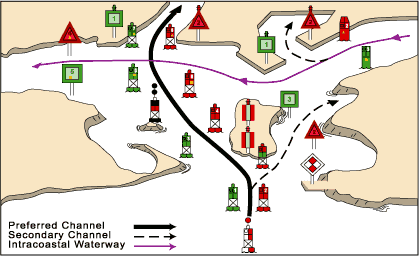 | ||
A lateral buoy, lateral post or lateral mark, as defined by the International Association of Lighthouse Authorities, is a sea mark used in maritime pilotage to indicate the edge of a channel.
Contents
Each mark indicates the edge of the safe water channel in terms of port (left-hand) or starboard (right-hand). These directions are relative to the direction of buoyage; this is usually a nominally upstream direction. In a river, the direction of buoyage is towards the river's source; in a harbour, the direction of buoyage is into the harbour from the sea. Where there may be doubt, it will be labelled on the appropriate chart. Often the cardinal mark system is used instead, when confusion about the direction would be common.
A vessel heading in the direction of buoyage (e.g. into a harbour) and wishing to keep in the main channel should:
IALA System
Marks are distinguished by their shape and colour, being red or green.
For historical reasons, two different schemes are in use worldwide, differing in their use of colour. Previously there had been 30 different buoyage systems, before IALA rationalised the system. In 1980 on a conference convened by IALA, they agreed to adopt the rules of a new combined system, which combined the previous two systems (A and B) into one system, with two regions (A and B).
The IALA defines them as Region A and Region B:
Region A
Region B
Both regions
The shape is an important feature, as colours cannot be distinguished in some light conditions, or by persons with red-green colour blindness. Marks may also carry unique markings of letters and numbers; these may be used to identify the mark as one indicated on a nautical chart. Likewise, a mark's light may flash in a distinctive sequence for the same purpose.
Also defined in the lateral mark systems is a bifurcation mark, which has both red and green horizontal bands, one over the other. This mark indicates that a "preferred" channel (often, a deep channel suitable for heavy commercial traffic) lies to one side, and a secondary channel on the other. Vessels wishing to use the preferred channel observe the top colour of the mark, and vessels wishing to use the secondary channel observe the bottom colour.
In Region A only, the phrase "Is there any red port left?" (referring to the red colour of the fortified wine "port") may be used as a mnemonic, indicating that a red mark must be kept on the left when "returning" to (i.e., entering) a harbour or river.
In Region B only, the phrase "red right returning" may be used as a mnemonic, indicating that a red mark must be kept on the right when returning to (i.e., entering) a harbour or river.
